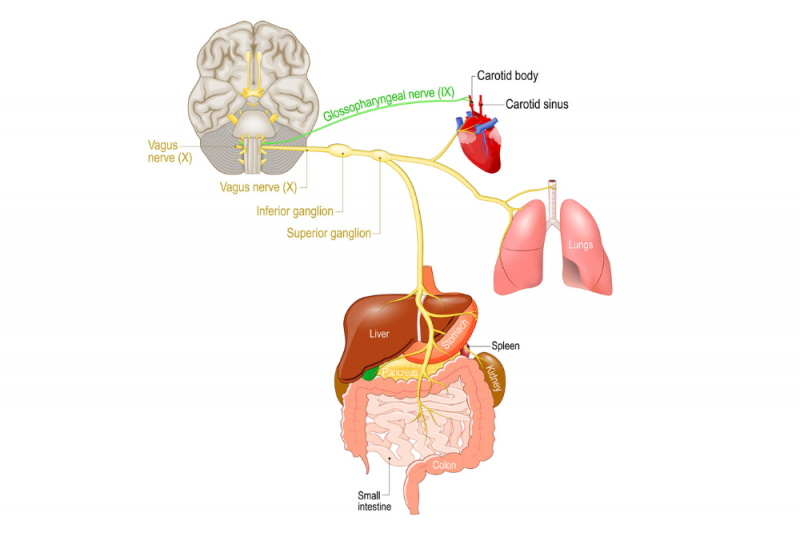A woman sits on her bed in a meditation pose with her eyes closed and with upturned hands resting on her knees, thumbs and middle fingers touching
Let’s explore what the vagus nerve is, and how you can protect it to benefit your mind and body.
The vagus nerve starts in your brain with 11 other cranial nerves. These 12 nerves located in the back of your brain come in pairs. Their job is to help link the brain to different parts of your head, neck, and torso.
These nerves work together to help you taste, smell, hear, and move your facial muscles (mind-blowing work). They are a key part of your nervous system.
You’re probably thinking, if there are 12, why are we just focusing on one? Well, we’re glad you asked.
Quick links
- What does it do?
- When things go wrong
- Signs and symptoms
- Keeping your vagus nerve happy
- More information
What does it do?
All 12 cranial nerves have specific functions, and the vagus nerve is like the Buddha of your brain. We’ll explain why this is shortly.
It’s the longest cranial nerve in the body (the longest of all the body’s nerves is the sciatic nerve). Its specific function is to carry signals between your brain, heart, and digestive system. It helps control functions such as:
- digestion
- heart rate, blood pressure and breathing
- immune system responses
- mood
- mucus and saliva production
- skin and muscle sensations
- speech
- swallowing
- taste
- urine output.
It also helps your body switch from its fight-or-flight mode (triggered by high stress) to its parasympathetic mode (our resting state)—hence the Buddha reference.
When things go wrong
The vagus nerve is not indestructible and can lose its ability to switch back to your parasympathetic mode. This is known as vagal dysfunction and can be due to factors such as infection, inflammation, brain trauma, stroke, or part of the ageing process.
This dysfunction can potentially lead to postural hypotension (low blood pressure on standing).
It can also lead to a condition called gastroparesis. Gastroparesis affects the involuntary contractions of the digestive system and prevents the stomach from properly emptying.
Vagal nerve dysfunction can cause both slow and fast heart rates depending on the type of dysfunction. Overactivity can lead to bradycardia (or slow heart rate). Disease causing insufficient activity of the vagus nerve can lead to tachycardia (or fast heart rate).
Signs and symptoms
Signs someone may have vagal dysfunction:
- changes to heart rate, blood pressure or blood sugar
- difficulty swallowing or loss of gag reflex
- dizziness or fainting on standing
- hoarseness, wheezing or loss of voice
- loss of appetite, feeling full quickly, bloating, unexplained weight loss, nausea and vomiting.
Keeping your vagus nerve happy
The best way to protect your vagus nerve is to make slight changes to your lifestyle. Be physically (and mentally) active, eat a healthy diet, and manage conditions like diabetes and high blood pressure.
It’s also important to take steps to control your stress levels and improve your overall health by:
- meditating
- exercising
- humming, singing, or listening to calming music
- massages
- breathing more slowly and more deeply, from the belly. Think about expanding your abdomen and widening your rib cage as you inhale.
Working on keeping your vagus nerve happy will help you respond more effectively to emotional and psychic stresses in your life.


